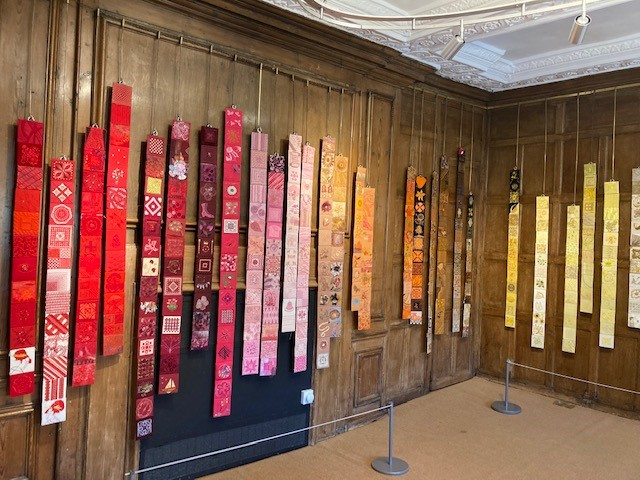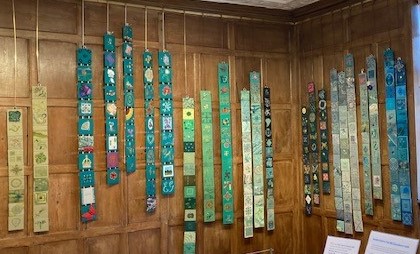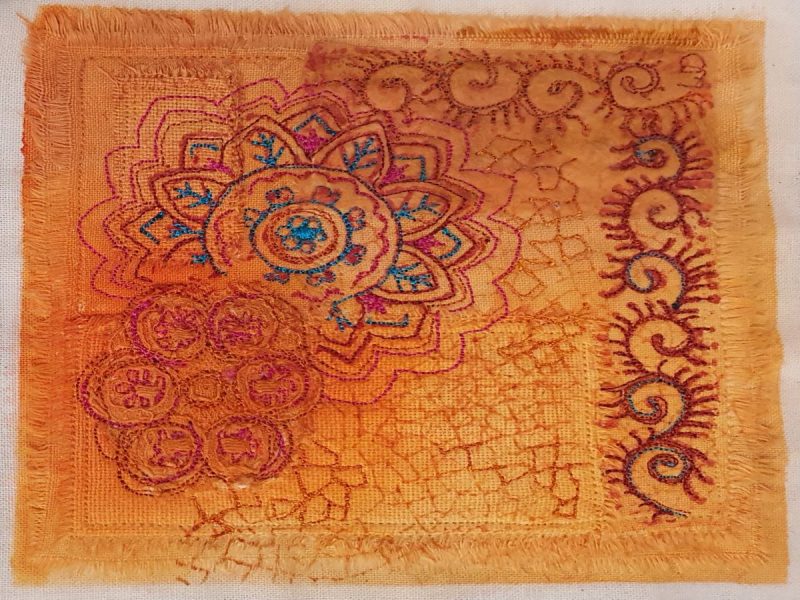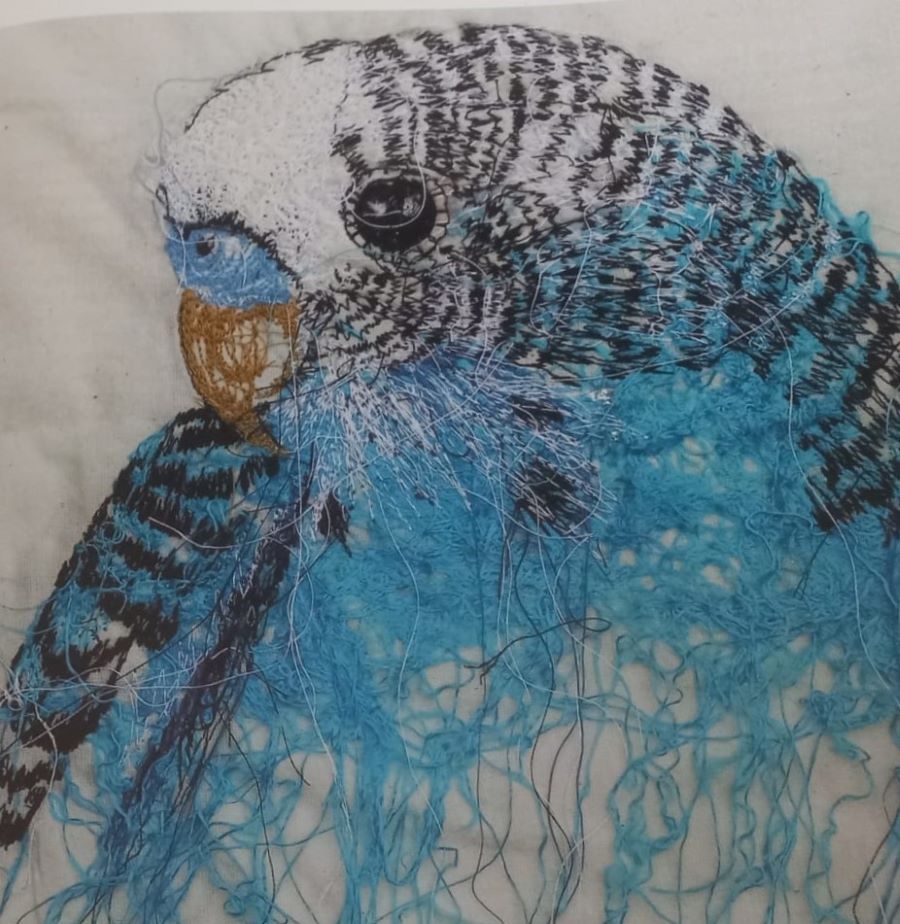 Thanks for Jane Baskerville for sending these photos of work by Julie French, who was the speaker for our June meeting. I was sorry to miss it; it looks like an interesting combination of fine art and stitch.
Thanks for Jane Baskerville for sending these photos of work by Julie French, who was the speaker for our June meeting. I was sorry to miss it; it looks like an interesting combination of fine art and stitch.

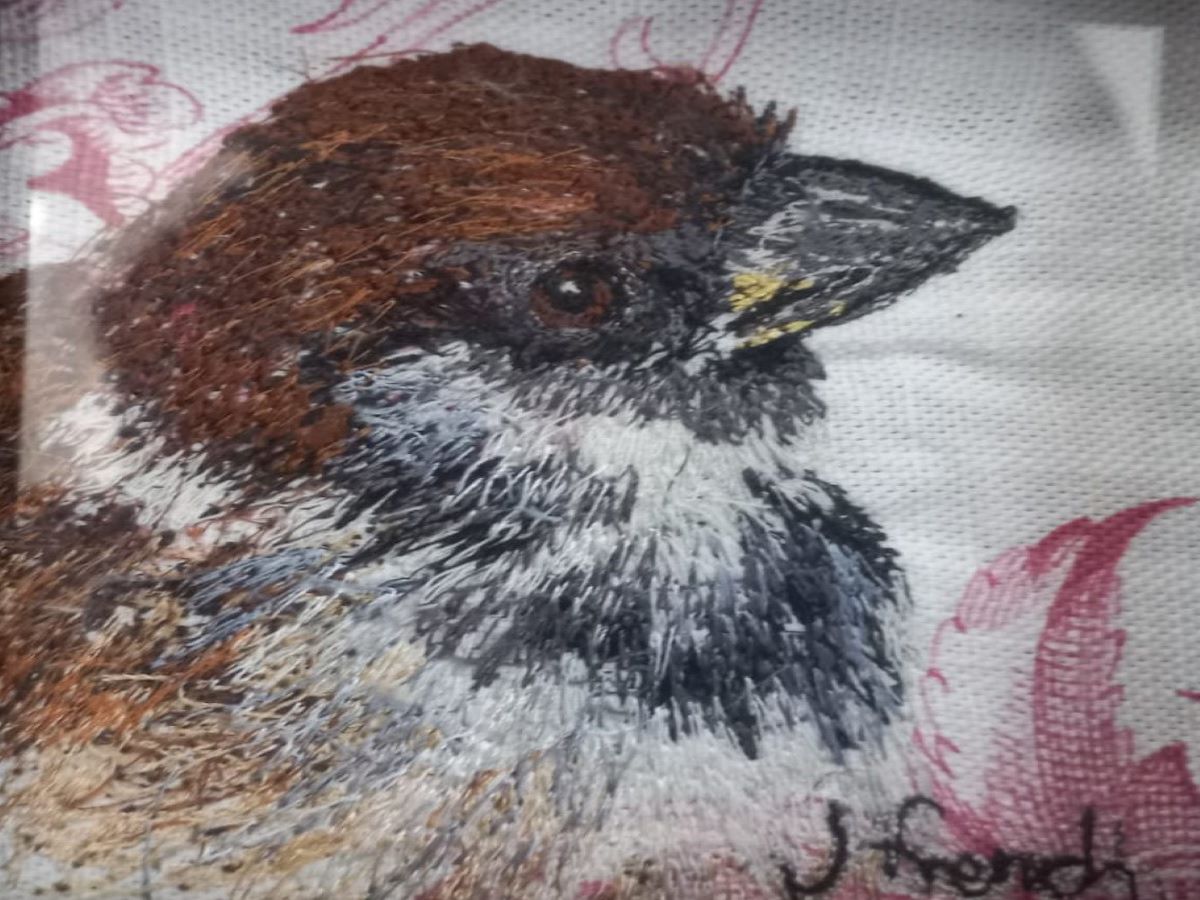


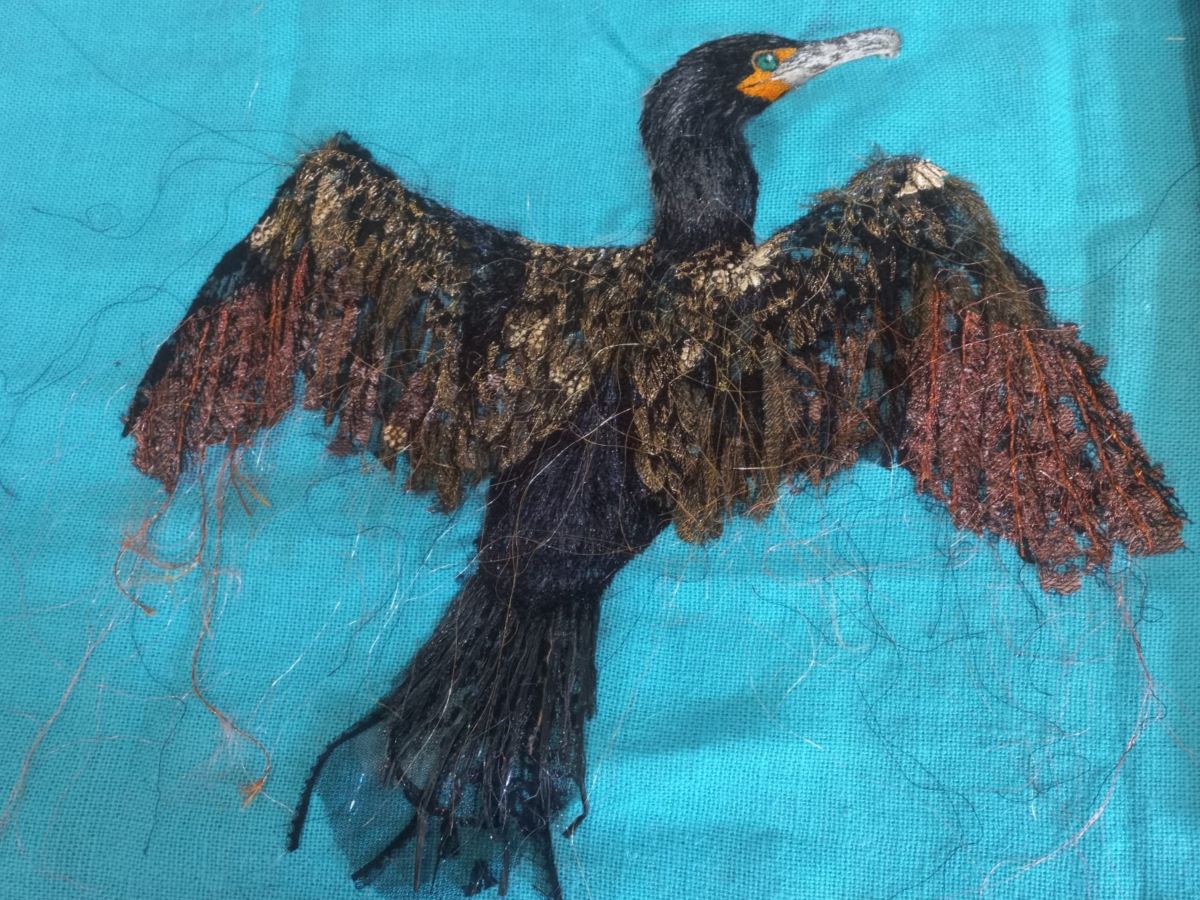
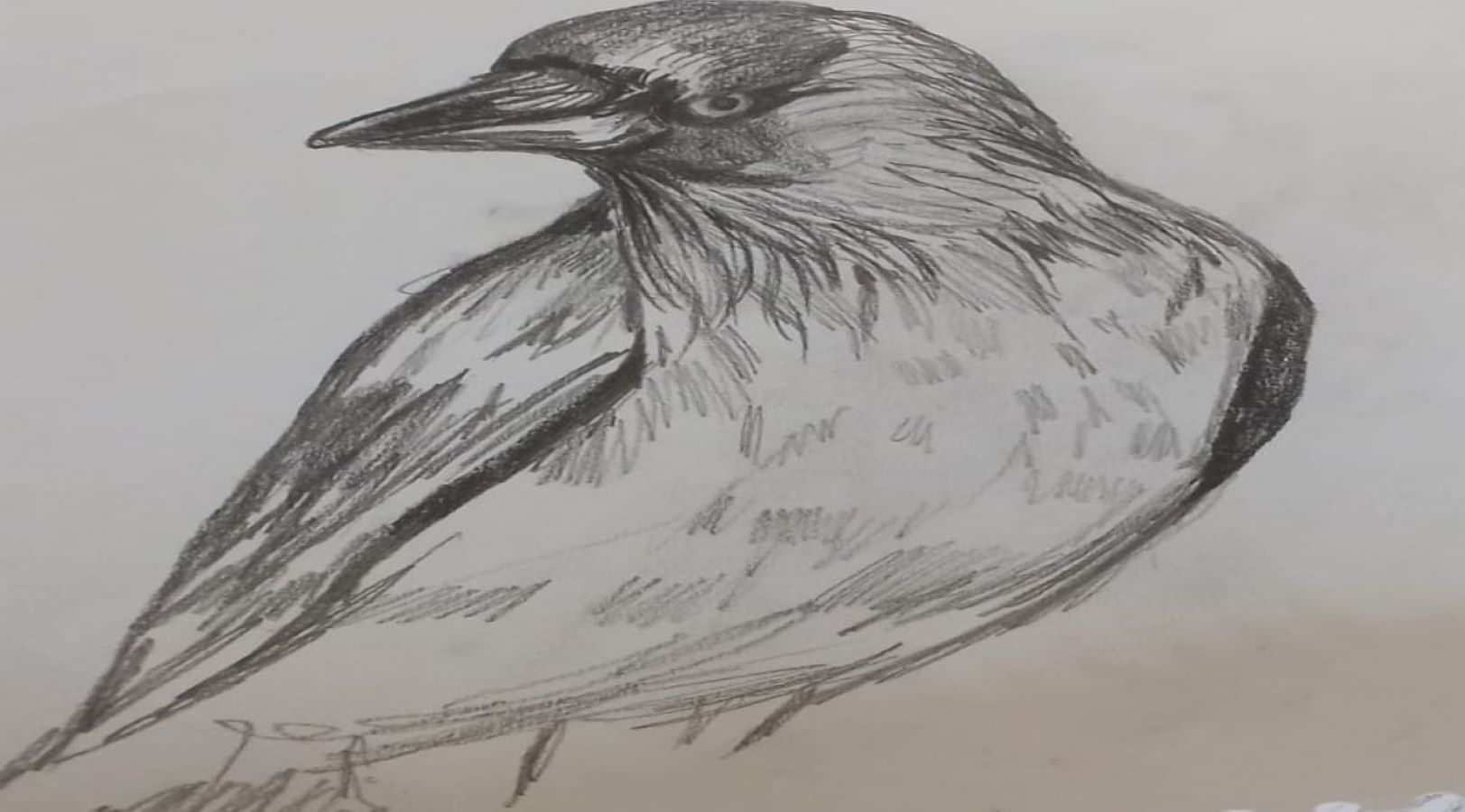

Author: Jane
Rainbow squares
 If you were a member way back when, you may have stitched one of these ‘Rainbow Squares’. It was a regional project where individual members of each group embroidered a square in the colour allocated to their group. They were then assembled in ‘chains’ and hung alongside the different colours from the other groups. You might like to know that they have been gathered together again, and exhibited at the Guildford House Gallery in Guildford (ours are the dark green ones). I saw them all together once a few years ago, and they look amazing in real life. You can see them there from today until to June 15th. It’s a long way to go, but Guildford is a nice place for shopping and a day out. Apologies for the quality of the photos (they lost quality through being emailed to me).
If you were a member way back when, you may have stitched one of these ‘Rainbow Squares’. It was a regional project where individual members of each group embroidered a square in the colour allocated to their group. They were then assembled in ‘chains’ and hung alongside the different colours from the other groups. You might like to know that they have been gathered together again, and exhibited at the Guildford House Gallery in Guildford (ours are the dark green ones). I saw them all together once a few years ago, and they look amazing in real life. You can see them there from today until to June 15th. It’s a long way to go, but Guildford is a nice place for shopping and a day out. Apologies for the quality of the photos (they lost quality through being emailed to me).
Textile treasures at Worthing museum
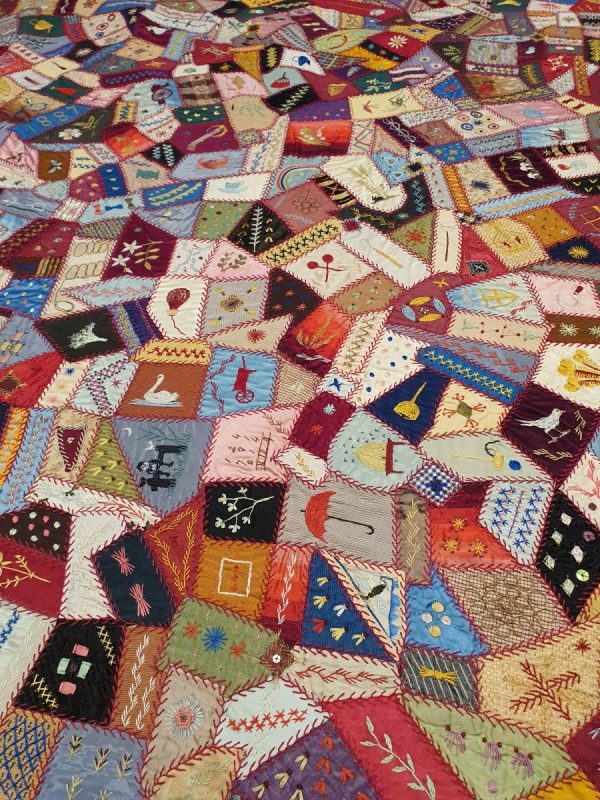
What a delightful morning we had at Worthing museum, enjoying a ‘show and tell’ session with Gerry Connelly, Head of Museums and Exhibitions. Gerry started his career in fashion design, before specialising in the History of Fashion. Gerry was the perfect person to show us some of the wonderful items that are owned by the museum but are not usually out on display.
Gerry started by showing us the oldest item in the collection, a blackwork jacket dating from 1610. It’s amazing that it is so well preserved.
We had a wonderful range of items to look at closely, and it’s lovely to see them without the reflections that you get when they’re behind glass. A couple of Elizabethan dress items: a fragment of embroidery that was probably originally on a jacket, and an embroidered glove that was probably given as a symbolic gift rather than for regular use, although it was interesting to see the signs of wear on the underneath.
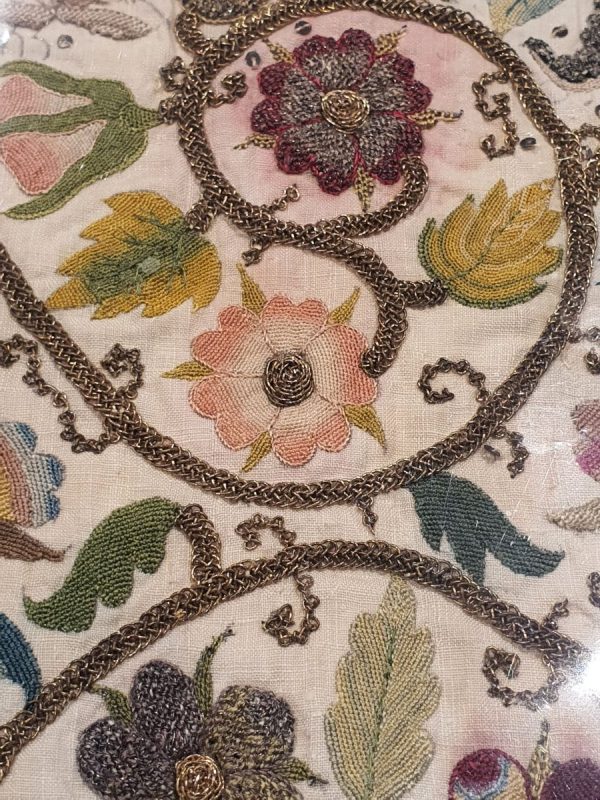


We saw a stunning embroidered waitcoat that could have come straight out of ‘The Tailor of Gloucester’ story, with stitching so fine that it could well have been stitched by mice.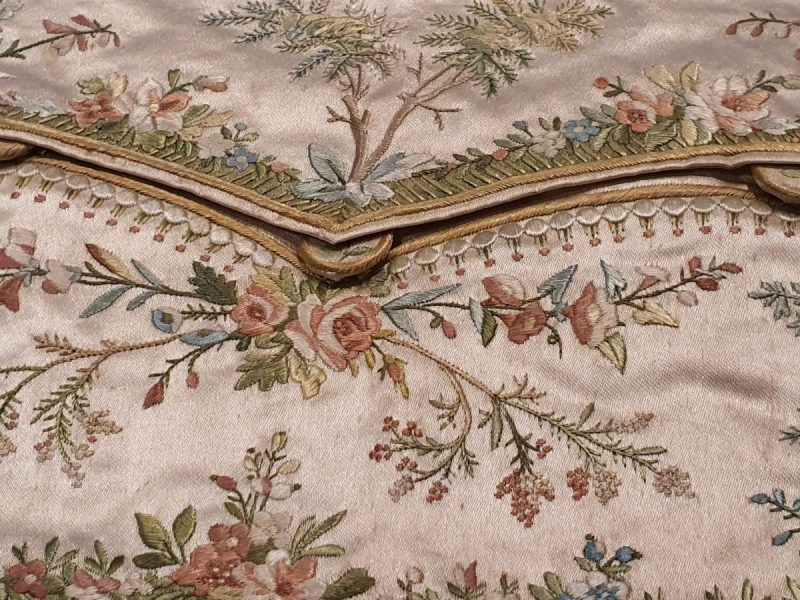
It was lovely to have time to study the details, and we could have happily stayed there all day.
Gerry brought out an embroidery called ‘The Warwick Street Embroidery’, which was stitched by our group in 2004. We had searched for it and no-one was sure where it was, but we were delighted to see that it is in the safe care of the museum. The embroidery was created by cutting up a historic photograph of Warwick Street, and distributing the cut-up rectangles to individual members to stitch. It was then re-assembled to re-create the picture. The names of the individual embroiderers were stitched on the back.


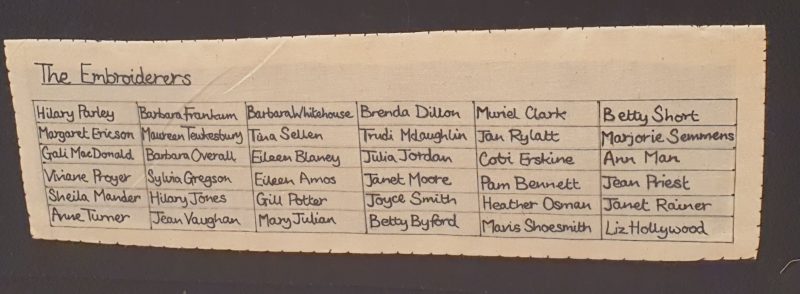
Lunch together afterwards was a lovely way to end the visit. Thanks to Chris for organising it all.
Grass doesn’t have to be green…
 The hall was full for our talk this month by Wendy Dolan. Wendy is well known to many of our members; she is a go-to tutor for machine embroidery courses in our area, and there were many of her current and former students in the audience. There were quite a few new visitors who came along specifically to hear Wendy’s talk.
The hall was full for our talk this month by Wendy Dolan. Wendy is well known to many of our members; she is a go-to tutor for machine embroidery courses in our area, and there were many of her current and former students in the audience. There were quite a few new visitors who came along specifically to hear Wendy’s talk.
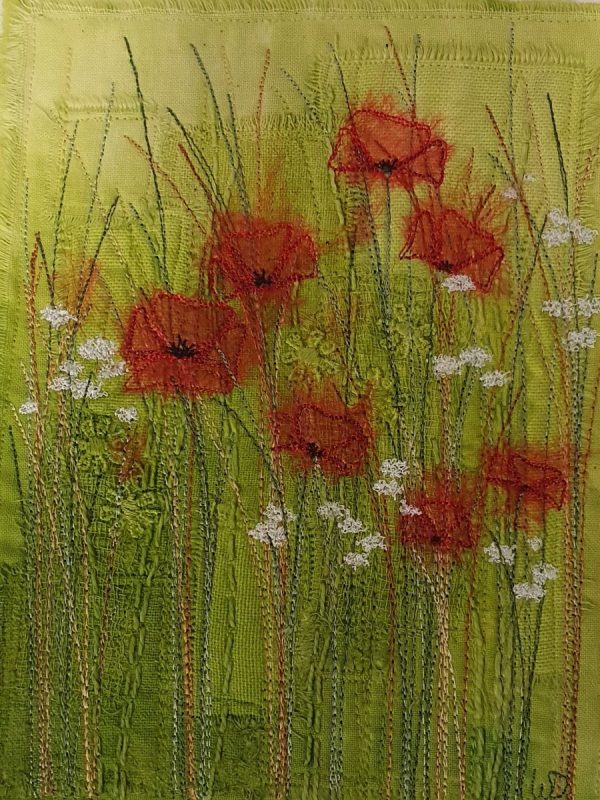 Before focussing on her inspirations and techniques, Wendy touched on some of the highlights of her textile journey. Starting as a child with cross-stitch and dressmaking, she was then taught traditional hand embroidery by a local embroiderer after school. This led her to a B.Ed. degree in art and textiles, where she was introduced to free-machine embroidery. One thing led to another, and she has had a varied and successful career in textile art and teaching ever since. She shared some highlights, including making two enormous curtains for cruise ships, exhibiting internationally, publishing articles and books, and showing her work and leading workshops at all the big textiles shows.
Before focussing on her inspirations and techniques, Wendy touched on some of the highlights of her textile journey. Starting as a child with cross-stitch and dressmaking, she was then taught traditional hand embroidery by a local embroiderer after school. This led her to a B.Ed. degree in art and textiles, where she was introduced to free-machine embroidery. One thing led to another, and she has had a varied and successful career in textile art and teaching ever since. She shared some highlights, including making two enormous curtains for cruise ships, exhibiting internationally, publishing articles and books, and showing her work and leading workshops at all the big textiles shows.
 Wendy described some of her sources of inspiration, which include landscape, architecture (doors, windows, arches, tiles, columns, spires, domes etc. ), people, fashion, nature (flowers, trees, lichens etc.), museums, maps, travel and many more. Some are consciously recorded with photos and sketches, and others are absorbed more subconsciously. She spoke about looking more closely at the details and textures, and focussing on particular areas of a picture.
Wendy described some of her sources of inspiration, which include landscape, architecture (doors, windows, arches, tiles, columns, spires, domes etc. ), people, fashion, nature (flowers, trees, lichens etc.), museums, maps, travel and many more. Some are consciously recorded with photos and sketches, and others are absorbed more subconsciously. She spoke about looking more closely at the details and textures, and focussing on particular areas of a picture.
 Wendy brought samples with her that show the different stages that her work goes through, starting with un-dyed fabrics, pinned into place and then stitched down in white. Then a rough colour experiment is done with collaged paper and paint, and this is used as a guide for adding colour to the fabric with water-based fabric paint. Additional texture might be added with Xpandaprint (puff paint), fresco flakes, and horticultural fleece which irons onto the fabric and resists dyes (and makes good clouds). After that, more detail is added with the sewing machine.
Wendy brought samples with her that show the different stages that her work goes through, starting with un-dyed fabrics, pinned into place and then stitched down in white. Then a rough colour experiment is done with collaged paper and paint, and this is used as a guide for adding colour to the fabric with water-based fabric paint. Additional texture might be added with Xpandaprint (puff paint), fresco flakes, and horticultural fleece which irons onto the fabric and resists dyes (and makes good clouds). After that, more detail is added with the sewing machine.

 Fragments of maps may be added by using an inkjet printer on fabric, ironing it temporarily onto freezer paper and taping the top with masking tape so that it will go through without wrinkling (Wendy recommends that if you share a printer with someone else, you wait until that person is out of the house so they don’t see what you are doing!) This method of printing is colour-fast if the fabric is first treated with Bubblejet 2000 solution, or you can buy ready-made fabric transfer sheets for the printer. All very useful information!
Fragments of maps may be added by using an inkjet printer on fabric, ironing it temporarily onto freezer paper and taping the top with masking tape so that it will go through without wrinkling (Wendy recommends that if you share a printer with someone else, you wait until that person is out of the house so they don’t see what you are doing!) This method of printing is colour-fast if the fabric is first treated with Bubblejet 2000 solution, or you can buy ready-made fabric transfer sheets for the printer. All very useful information!
Wendy likes to play with colour: sometimes she makes a very natural-looking landscape, and at other times she likes to play around with the colour-range, encouraging people to move away from restrictions such as thinking that grass must always be green.
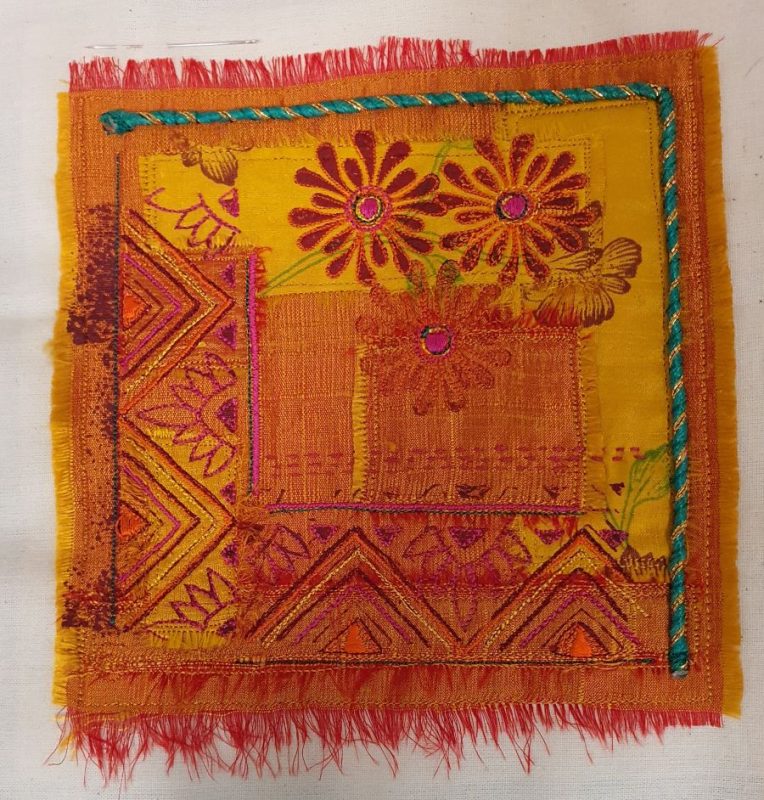 Wendy had just come back from leading a specialist textiles trip to India. She showed us some lovely samples that were inspired by those trips. If anyone is interested in trying these, or any other of Wendy’s techniques, you can find details of workshops on her website: https://www.wendydolan.co.uk/
Wendy had just come back from leading a specialist textiles trip to India. She showed us some lovely samples that were inspired by those trips. If anyone is interested in trying these, or any other of Wendy’s techniques, you can find details of workshops on her website: https://www.wendydolan.co.uk/
Strawberry brooch
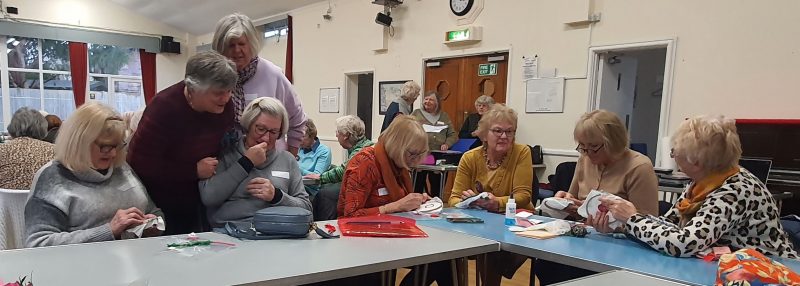 What a lovely relaxing day at our monthly meeting, which this month was a sit-and-stitch afternoon. Speakers are interesting and stimulating, but sometimes it’s also good to have time to catch up with people and stitch in company. Daphne kindly led a ‘Stitch Corner’ session, making strawberry brooches. Scroll down for some photos of the group working on their brooches, and at the end a finished one that was stitched by Michelle.
What a lovely relaxing day at our monthly meeting, which this month was a sit-and-stitch afternoon. Speakers are interesting and stimulating, but sometimes it’s also good to have time to catch up with people and stitch in company. Daphne kindly led a ‘Stitch Corner’ session, making strawberry brooches. Scroll down for some photos of the group working on their brooches, and at the end a finished one that was stitched by Michelle.
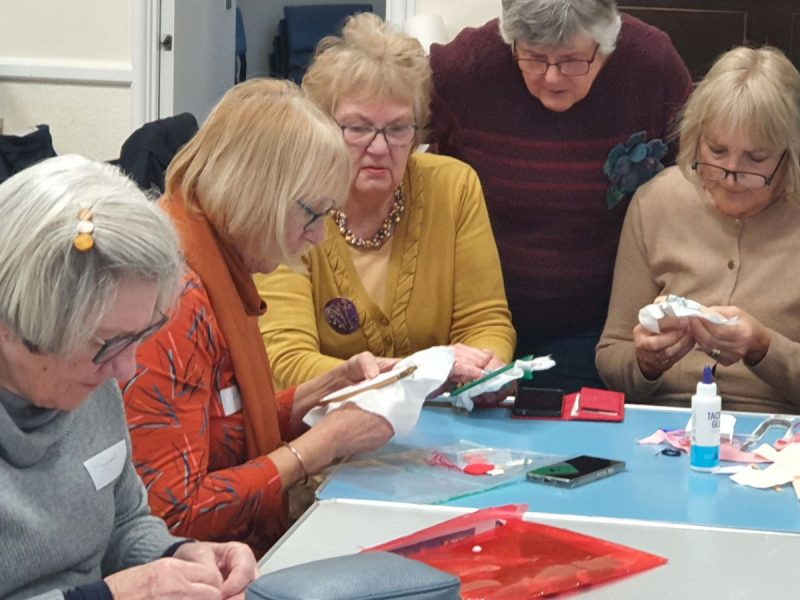


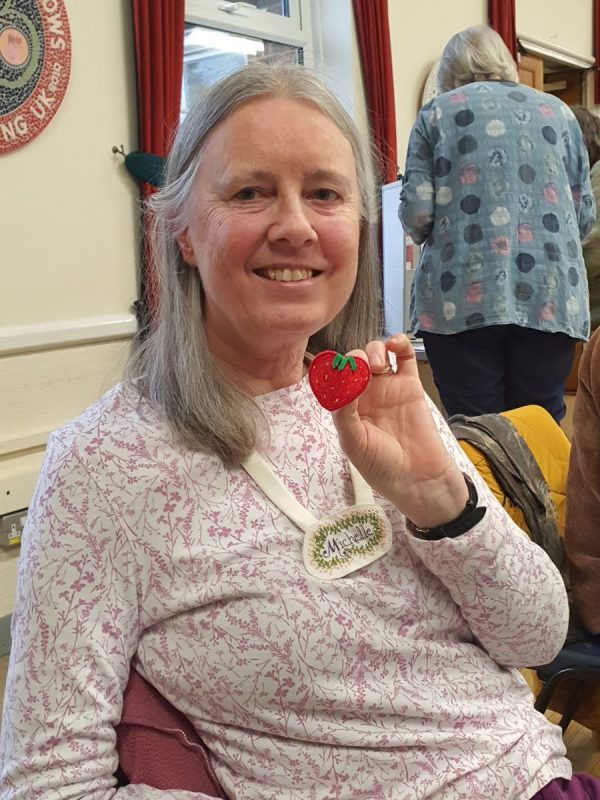
Ramster Embroidery Exhibition
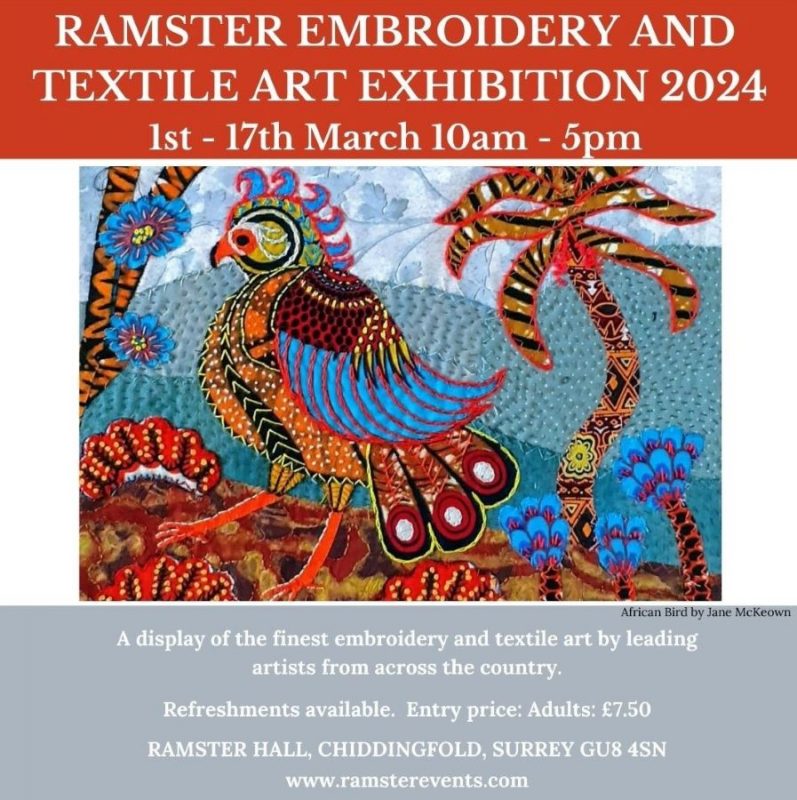 This exhibition is coming up soon. It’s in Ramster Hall, a lovely 17th Century manor house in Surrey. The exhibition will be open from Friday March 1st until Sunday March 17th every day from 10 am until 5pm. The tea room will be open at the same time. There are two large halls of embroidery / textile art exhibits, with a wide variety of styles. I know of 6 SCS members who are taking part. It’s a good day out, and the cakes are good!
This exhibition is coming up soon. It’s in Ramster Hall, a lovely 17th Century manor house in Surrey. The exhibition will be open from Friday March 1st until Sunday March 17th every day from 10 am until 5pm. The tea room will be open at the same time. There are two large halls of embroidery / textile art exhibits, with a wide variety of styles. I know of 6 SCS members who are taking part. It’s a good day out, and the cakes are good!
Quilts and machine embroidery
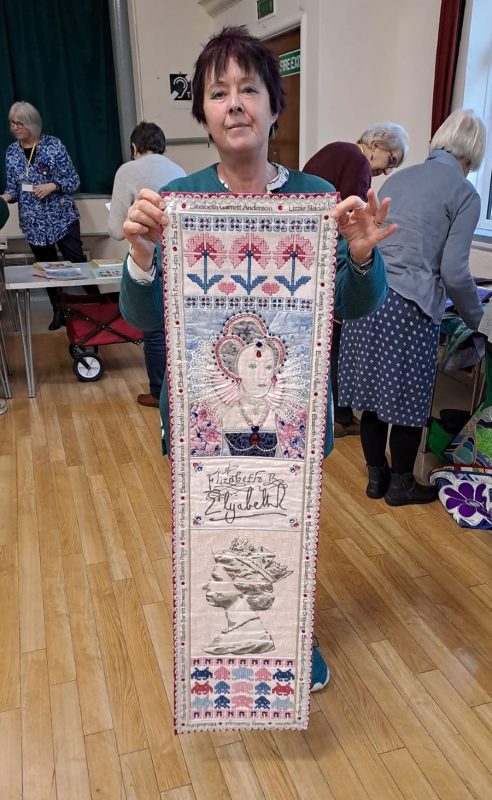
We had a great talk yesterday by Gail Lawther. There’s a description of it on our FB page, so I won’t duplicate that here. Gail didn’t want her work photographed (sadly, people sometimes steal other people’s designs) so this month I can’t post any photos here, except for this one that she kindly let Chris take. Gail is running a workshop for us on 15th March, making wall-quilts based on ‘twilight silhouettes’. There are still a few places available, although it is booking up fast so talk to a committee member if you would like to book a place.

Several members have said to me recently that they don’t feel confident going on workshops that involve the sewing machine. If you want a gentle introduction to machine embroidery, Esther Collins is starting a new course near Pulborough (not too far from sunny Worthing) where she will start with the basics and take you through it step by step. It’s six evenings in February and March. It should give you the confidence to join other workshops such as the one by Gail Lawther above. Details in the link below.


